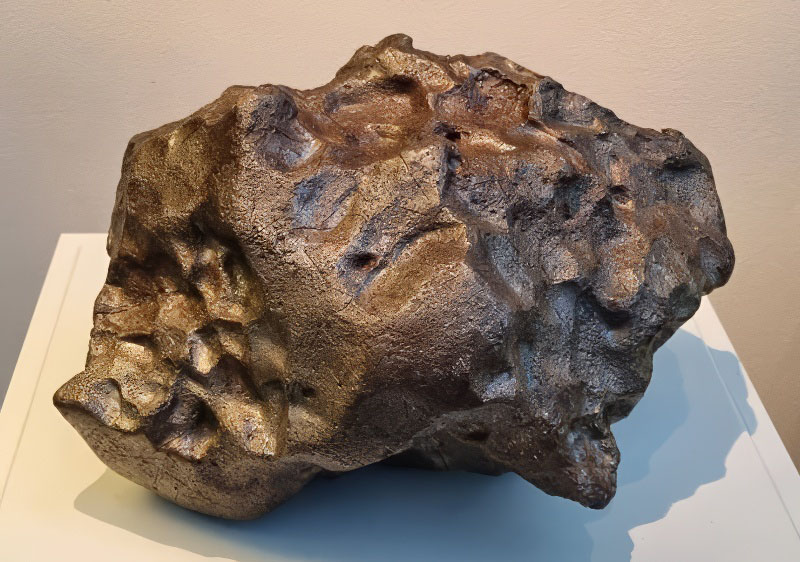|
Roll Overs:
1
2
3
4
5
6
7
8
9
10
11
12
|

|
|
Copyright (c) jnmczurich. Use allowed - include photographer's name:.
|
Iron, IIC
TKW 80kg. Fall not observed. Found 1920, Unter-Mässing, Germany.
   
jnmczurich writes:
The iron meteorite Unter-Mässing (U-M) was unexpectedly found in 1920 during excavation work near the junction of Röckenhofen and Oesterberg at a depth of about 1.5 m. U-M is still the largest meteorite ever found in Germany.
Pic 1 – U-M almost complete mass, on display in Natural History Museum of Nuremberg/Germany
U-M is structurally classified as IIC iron, plessite octahedrite (Opl) with 0.06 mm narrow kamacite spindles and is one of only eight meteorites worldwide with this IIC classification. The structure of U-M consists essentially of two phases, Ni-poor kamacite and Ni-rich taenite. Schreibersite (FeNi)3P (chemically Schreibersite is an iron-nickel phosphide) and troilite FeS (iron sulfide in stoichiometric equilibrium) are included in U-M as inclusions.
Since there were enough b/w micrographs of U-M iron known from the meteorite literature, the sample was carefully prepared for color etching by using Klemm-1 etching solution.
Please note: micrographs of a color-etched U-M sample are a novelty and have not yet been reported from any other source. However, most of the images shown here were presented to a small group of colloquium participants at the two years delayed (Corona restrictions…) German Meteorite Colloquium on the 100th anniversary of finding the U-M Iron, in August 2022.
Pic 2 and Pic 3 – polished U-M partial slice and the same U-M partial slice in color-etched condition. The red marked fields are showing the investigation fields - see following pictures. The black strips in the overview picture are cracks that are partially filled with Schreibersite. U-M is a cosmically strongly shocked iron meteorite.
Pic 4 – to guide you though the micro-photography images, please see investigation field 4 in Pic 2. Color etched U-M with 25 times magnification. Scale 500 µm.
Pic 5 – color etched U-M with 100 times magnification. Scale 100 µm.
Blocky or worm-like white/cream-colored, cracked schreibersite inclusions (S). Cracks in the schreibersite are caused by strong shock.
Blue/light blue colored Ni-poor kamacite (K).
White, thin taenite bands (T) border the blue/light blue/grey/light grey kamacite fields.
Brown areas finely speckled/streaked with blue are plessite (P).
Pic 6 – color etched U-M with 25 times magnification. Scale 500 µm.
Striking, vertically directed schreibersite inclusion. In the image is seen a slight efflorescence (discoloration) caused by the etching agent sitting deep in the cracks.
Pic 7 – color etched U-M with 100 times magnification. Scale 100 µm.
Horizontally directed schreibersite inclusion, enveloped by kamacite (grey in various shades), with narrow taenite bands delimited from the plessitic matrix.
Pic 8 – color etched U-M with 100 times magnification. Scale 100 µm.
Torn inclusion of schreibersite (white) as a probable consequence of a strong shock situation.
Brown areas finely speckled/streaked with blue are plessite.
Pic 9 – color etched U-M with 100 times magnification. Scale 100 µm.
Blocky schreibersite inclusions, streaked with cracks (white) in the middle of kamacite spindles (blue/grey). The kamacite spindles are
bordered by a thin white rim of taenite banding towards the plessitic matrix.
Pic 10 – color etched U-M with 100 times magnification. Scale 100 µm.
Several elongated kamacite spindles (various blue colors).
Blocky schreibersite inclusions with cracks in the kamacite spindles.
Fine blue/brown colored plessitic matrix.
Pic 11 and 12 – color etched U-M with 500 times magnification. Scale 20 µm.
Two pictures in higher magnification as a bonus to enjoy… |
Found at the arrow (green or red) on the map below
|
|
| |
John lutzon
9/4/2024 8:55:00 PM |
Every pic. is visually intriguing! P-1 is just simply beautiful; I'm finding it difficult to stop looking at the pointed nose face. Very nice |
John Divelbiss
9/4/2024 6:15:13 PM |
this post is a great visual teaching lesson about a rare iron. Pic 1....the big individual is quite special. thank you |
Graham Ensor
9/4/2024 4:15:27 AM |
Wonderful! |
matthias
9/4/2024 3:19:16 AM |
Seems to be surprisingly well preserved with all these concisely formed regmaglypts. Really awful. |
| |
|